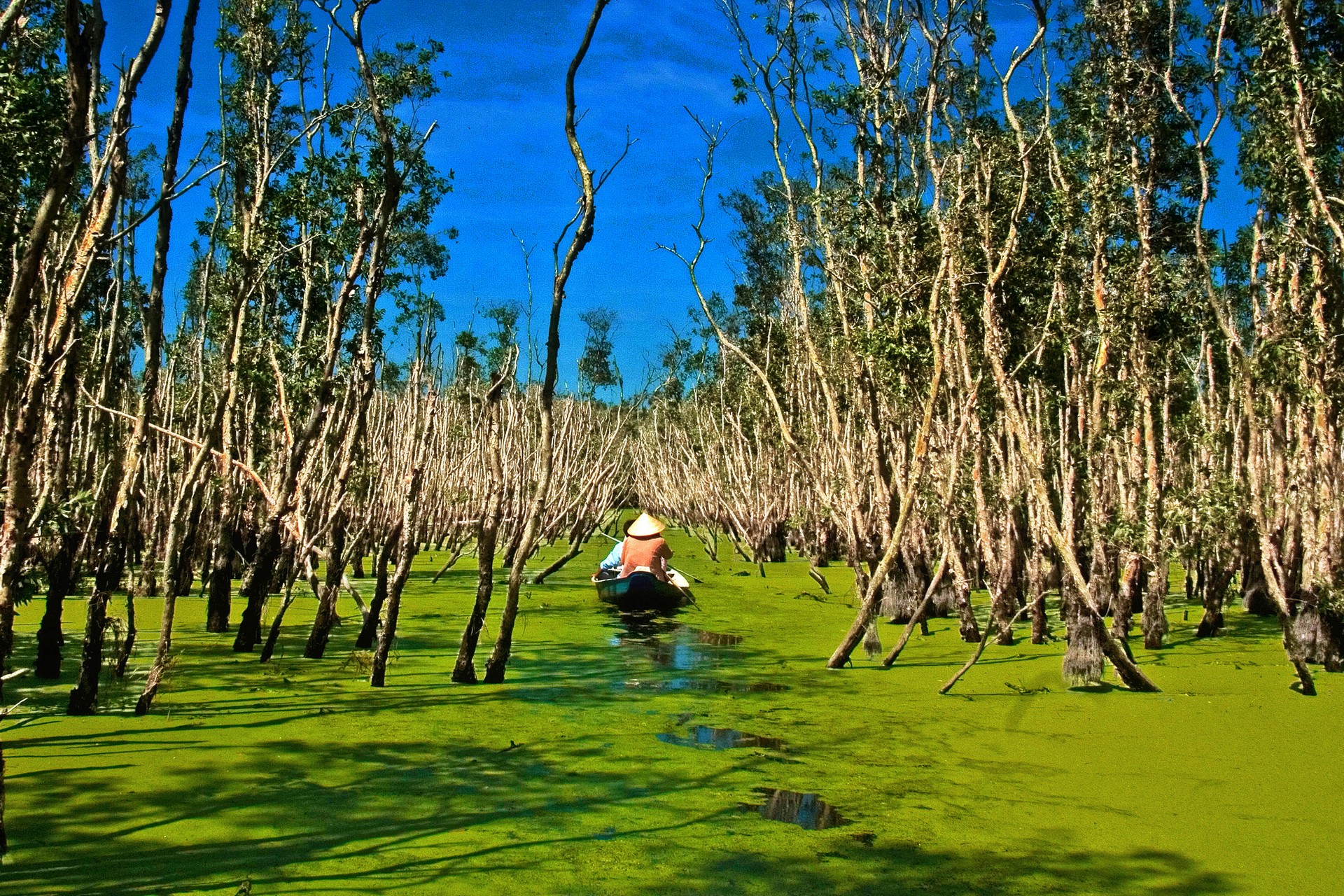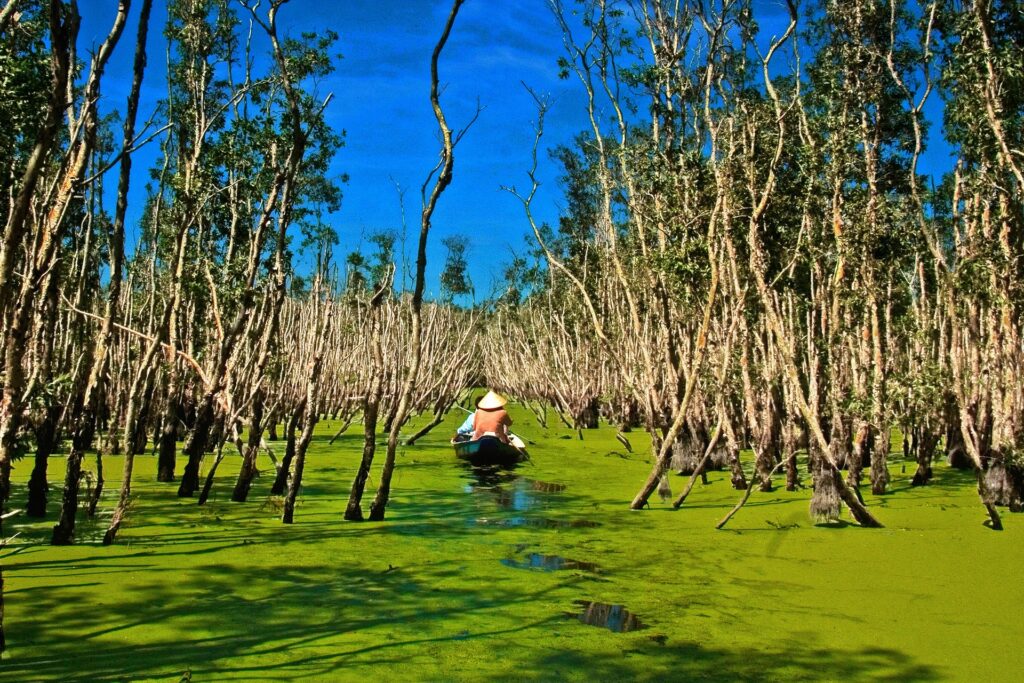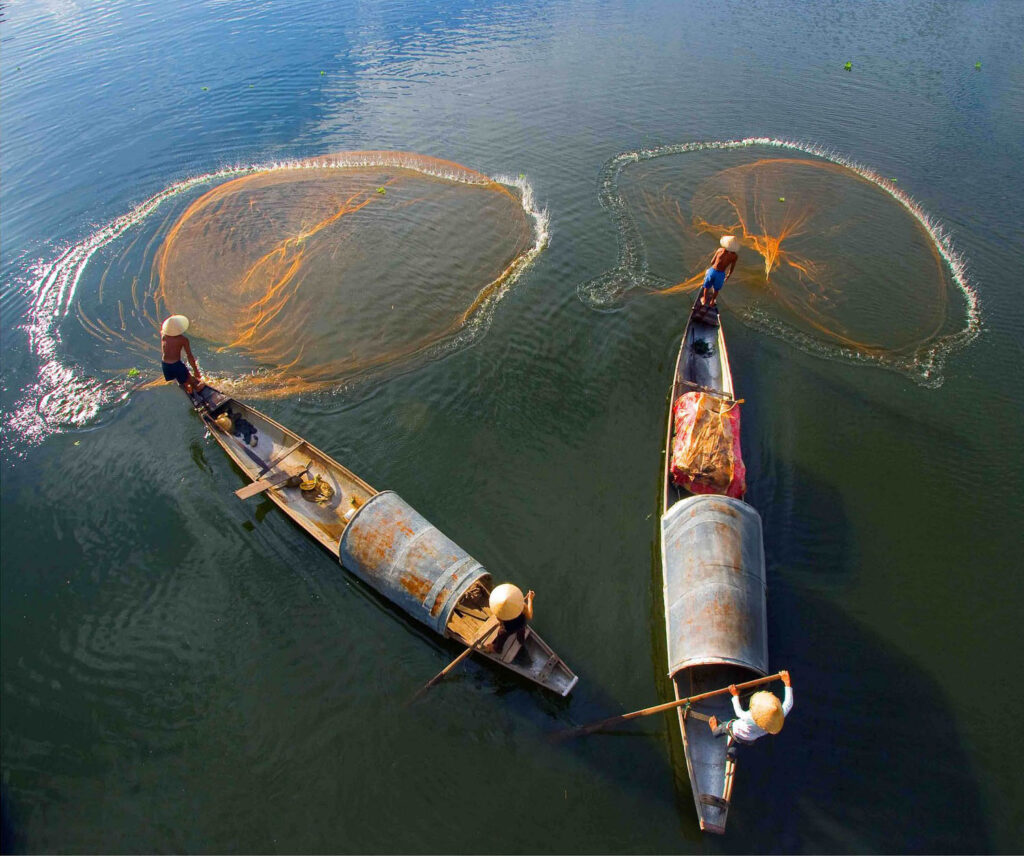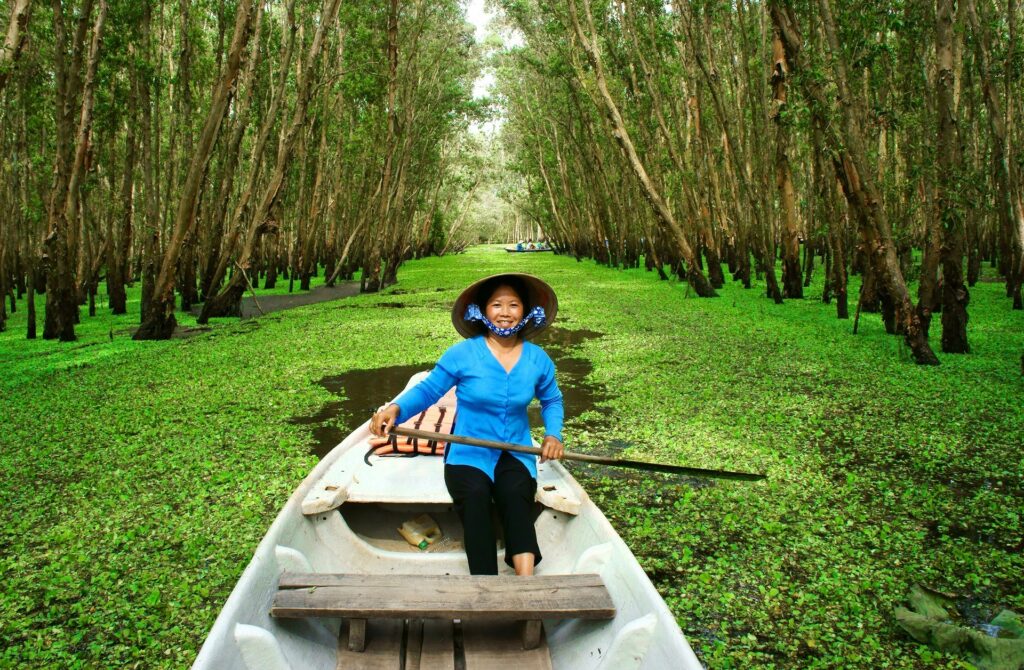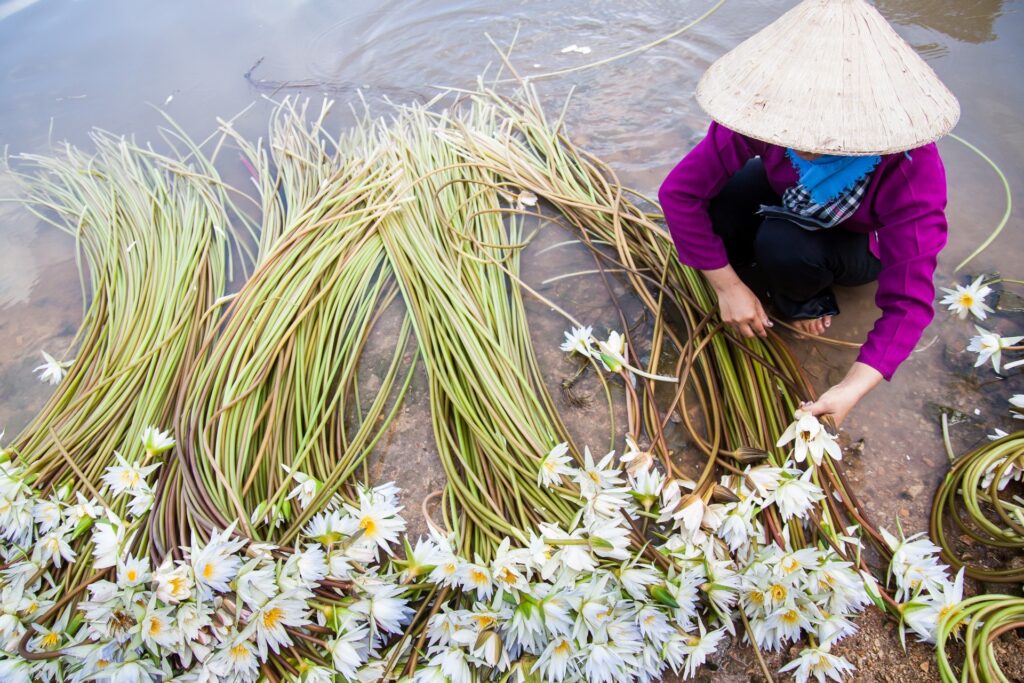Chau Doc
SEE AND DO
Tra Su Bird Sanctuary
This bird sanctuary is located about 23km from Chau Doc City and consists of a protected forest of cajuput trees and wetlands that attract a great variety of birds including storks, egrets, cormorants, peafowl and water cocks.
The Tra Su bird sanctuary (Tra Su forest) is a special place for nature lovers and well worth a visit. The forest covers an area of 850 hectares and is an important natural habitat for many colorful birds and other rare animals. There are more than 140 different kinds of plants in the sanctuaryand many of the Cajuputs, which are very common in the delta, can be found here. Tra Su is home to a rich array of bird and other wildlife that live among the canals and cajaput trees (tea trees) – all planted since the end of the Vietnam War. The best months to travel to Tra Su is when the Mekong is peaking between September and November.
The tour of the floating habitats is possible by motorboat, rowing boat or on foot. Since Tra Su forest is just 20 km from Chau Doc, you can combine a visit of Tra Su with one of our Mekong Delta tours
Chau Doc Floating Market
Chau Doc floating market is another famous market in the Mekong Delta (beside Cai Rang floating market, Phong Dien floating markets in Can Tho), wherein most of the activities of trading take place. Merchants from different places in Vietnam carry goods (mostly fruits and aquatic products) to Chau Doc and sell them to the locals and tourists. It becomes busiest from 7-8 AM and this is a great chance to visit one of the key economic regions of the Mekong Delta and enjoy the exciting and bustling atmosphere here.
Head out early and hold off on breakfast. Floating noodle, coffee and fruit stalls are in abundance in the market serving the market sellers and visitors.
Sam Mountain
Sam Mountain is about 8 kms from Chau Doc City – the highest mountain in Mekong Delta, located in the west of Chau Doc Town. This 230m high mountain is also one of the most beautiful landscapes in Vietnam with endless gold rice fields. On top of the mountain, you can have a really good view of the surrounding countryside and easily look out over Cambodia – a neighboring country of Vietnam. You can access the top of the mountain from the other side – the same road used to access the Victoria Nui Sam hotel.
The mountain does not only offer beautiful landscapes, but it is also where many historic remains deeply loved by the inhabitants of Nam Bo plain are located. Ba Chua Xu Temple, Tay An Pagoda, Thoai Ngoc Hau Tomb, Tao Ngo Garden, and Bach Van Hill are among the most famous sites to visit near Sam Mountain. To the top of the mountain, there is a shrine with good views of the surrounding countryside.
Chau Doc Fish Sauce Market
Chau Doc is also very famous in Vietnam for fish sauce. Therefore, Fish Sauce market should be one of the most worthy sites to visit once you travel to Chau Doc. It ensures an excellent spot for discovery and experience in the Mekong Delta. The market is in the head of Tien River and Hau River. There are many different kinds of fish sauce here with different flavors to try and taste. Don’t forget to discover this place.
Chua Moi Pagoda
The Moi Pagoda, built by the Khmer in 1880, is located on Road 91, 2km from the Tinh Bien International Border Market. Home to Theravada monks, it is a place of worship for the Khmer in the Xuan Hoa residential cluster.
Its architecture is a combination of the Khmer’s decorative art and the colourful designs of the Angkor culture. From its gates and roofs to interiors, there are numerous figures of birds, nymphs and Naga, the god of snakes.
The main hall has a high ceiling. An idol of the Buddha seated on a lotus is in the middle of the hall. The year of construction, which is recorded on a wall, was 2421 in the Buddhist calendar. We are now in 2563 in the Buddhist calendar.
Outside the main hall, under a canopy of palm trees is a long line of towers built by Buddhist followers. The towers have many different sizes depending on the donations made by each family.
In Khmer tradition, local people and Buddhists visit the pagoda to help prepare for festivals and other special celebrations. The photo shows the making of flowers for decorations during the inauguration of the pagoda’s new hall.
Tinh Bien Market
Tinh Bien, a border gate bounded by Cambodia in the Mekong Delta, is a large trading center attracting thousands of traders, shoppers and visitors.
From Chau Doc Town, it takes about 30 minutes to get to Nha Bang Town. From there, move on about ten kilometers heading to Xuan To Town to get to the Tinh Bien border gate market. Every day, tourists from HCMC and neighboring provinces. Attractive products are garments and wines. However, buyers have to be careful with brands, origins and expiry dates. Some people earn money from reselling goods.
Some people just think of buying souvenirs or eating indigenous specialties of the region. Tinh Bien Market sells almost everything and often attracts wholesale traders from around the delta as well as from other regions.
Women flock there to buy clothes and cosmetic products which are diverse in types and styles and are cheaper than in other places. The market is ideal for buying watches made in Thailand or China as they are fashionable and about half the price at other markets.
EAT AND DRINKS
Fermented seafood (Mam)
Chau Doc is known as the capital of fermentation, or mam in Vietnamese, and locals use many spices to preserve various kinds of seafood. Vietnamese usually eat mam with rice. It tastes slightly sweet at first, but has a salty aftertaste.
Mam is so iconic here that even tourists buy it as a gift. The best place to find and try this dish is Chau Doc Market.
Chau Doc fish noodle soup (Bun ca Chau Doc)
Originated in Cambodia before people in the Mekong Delta tweaked it to fit their taste, this special dish has the main ingredients as snakehead fish, broth and noodles. The success of the dish lies in the broth that is made from fermented carp, shrimp paste and livestock bones. It also has a pale yellow color from crushed turmeric and fried fish is added to enhance its flavor.
The dish is served with a plate of roasted pork (heo quay) and sesban leaves from a plant that grows abundantly in the region and has a unique aromatic texture and subtle fatty taste. We had probably a half dozen bowls of this across our four days in Chau Doc and our two favourites were Bun Ca Be Hai on Chi Lang, on the south side of the Buddhist temple and Bun Ca Di Le, set on Le Cong Thanh behind the Nguyen Huu Canh temple near the market. The latter was especially delicious.
Beef intestine sausage (Tung lo mo)
This is a regional dish of the Cham ethnic people living in Chau Doc. The Cham around Chau Doc, who practice a form of Islam, abstain from pork. So tung lo mo has become a staple beef dish during religious ceremonies, as visitors often see strings of sausages hung to dry up everywhere along the streets on the outskirts. Locals cut it into small slices and grill on a charcoal stove until it gives off a fragrance. When it is cooked, they chop it up into desirable sizes.
Fine rice vermicelli sheets with grilled pork (Banh hoi heo quay)
Banh hoi is similar to rice vermicelli and made from rice flour into very fine sheets. The dish is most delicious when it is soft and covered with a thin layer of oil to get rid of the raw flour flavor. Locals eat banh hoi with pieces of marinated and fragrant pork that are grilled over charcoal.
The dish is topped with fatty onion and crushed peanuts. Some stalls add spring rolls (cha gio) and fish cakes (cha ca) to the dish. Every element comes together when eaten
with sweet and sour fish sauce. It can be dipped into the sauce or the sauce can be added to the dish.
Sesbania sesban sour soup (Canh chua bong dien dien)
Whoever comes to An Giang in the rising season will know about the famous Sesban sour soup. The main ingredients are the sesban, lotus branches, tamarind, herbs, chili, dangila fish or perch. The sesban has to be picked during the early time of the flood season, which is sweet and fleshy, with a yellow color and a dishtinghish smell.
Eating the soup and you will never forget the sweet of the vegetable, the sour of the tamarind, the additional sweet from the fish, and the spicy of chili.
The vegetable is also used to fry shrimps, or to stuff the Vietnamese traditional pancakes. All of the dishes combined to make a nice and delicate banquet of the countryside which no restaurant can offer. In the midday of the flooding season, with the rains are pouring outside, there is nothing better than a bowl of sesban soup and a pancake.
Danio dangila (Ca linh)
During the flooding season in the Mekong Delta, usually from late August, the dangilas, after laying eggs in the Lake Sea, come down to Tien (Ti?n) and Hau (H?u) Rivers to find food. The locals have two famous dishes made of the fish: the fried floured dangila and the hot pot of dangila and sesban. The first dangila during the early of the flooding season is fat, soft, and you can even their bones. When cooking, you don’t have to remove the fins, just remove the guts, soak with salt water to remove the slimes and cook the fish.
The best dish is dangila cooked with sour soup and eaten along with rice vermicelli. The sour soup is made of tamarind, herbs, cilantro, and basil. The fish, after cleaned and removed the guts, is put separate from the soup with the yellow sesban. When the soup is cooked, put the fish and the sesban into the soup together. The fish is soft combined with the crunchy sesban is a wonderful combination.
Beside from the sour soup and the braised with tamarind, the dangila is also made into many other dishes such as vinegar-dipped dangila, fried floured dangila, sugar cane braised dangila, fish roll, fish sauce, and even canned. All are delicious, yet the cooked dangila eaten with herbs are the things you will never forget.
Scorpions (Bo Cap)
Coming to the two mountainous districts of Tinh Bien and Tri Ton, you should definitely try the crunchy fried scorpions. We all know how a scorpion looks like, and their venoms are very dangerous. They usually live in hallow trees, bushes and needed to be careful when attempting to catch one. You should definitely leave the catching to the professional and mind your eating business. After catching the insect, and leaving them for a few days so their bellies can be emptied, the chef will wash them again, and fry them on the frying pan full of oil.
The fried scorpions also required some herbs to eat with. Some such as cilantro, parsley, and vegetables like tomatoes and cucumber, some pepper-n-salt lemon sauce or soy sauce will be perfect. Crunchy and tasty, the scorpions are fat and sweet. The best part is the belly, where beside the taste of the herbs, there is also a taste which no bug has. There is also the dish fried scorpions with butter, which is equally amazing. The scorpions are also used to make wine and according to the Khmer people, eating scorpions and drinking scorpions wine will have relieve pain, and enhance energy.
Moi market fried sticky rice bubble (Xoi Phong Cho Moi)
Moi Market is famous for many agriculture products and cuisines. The fried sticky rice bubble is one of the most famous dishes of the market. The rice in the region, thanks to the red mud, is highly qualified with the grains are round, fat and beautiful. The fried sticky rice is yellow, and tasty.
The main ingredient for the bubble is the sticky rice, but unlike many other types of sticky rice, the rice is smashed and mixed with sugar, pea. After the mixing process, the rice is fried until it has the shape of a bubble. The bubble has to be round, not to chewy, yellow and soft. The inside is also yellow. Eating the sticky rice, you can also dip the rice in chili sauce, soybean sauce. You can eat the sticky rice with fried or grilled chicken. The chicken meat has to be chewy and sweet, and have to be grilled manually. The shop Kim Huong of Ms. Hong Thu in Cho Moi Town is one of the best.

Loan Tran
Traveling and having personally touched experiences of luxurious services; exploring new, attractive and unique products at each destination is my great passion during the last two decades of working in traveling industry. For me, traveling is all about memories and experiences.

